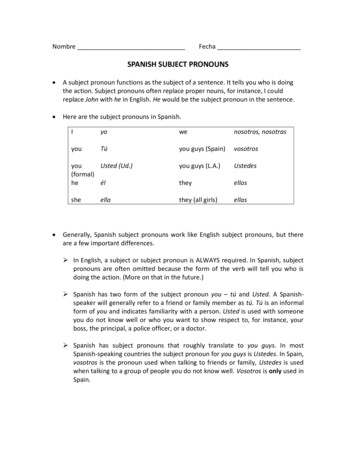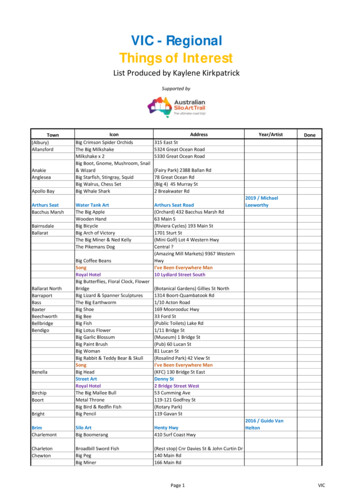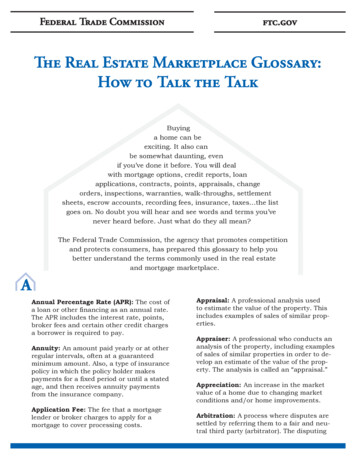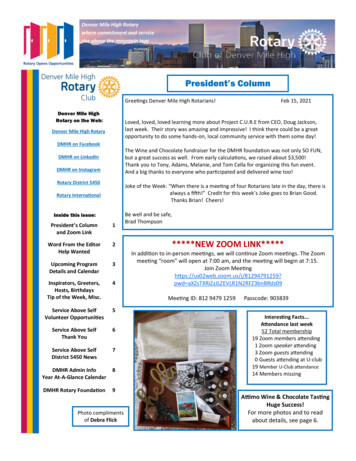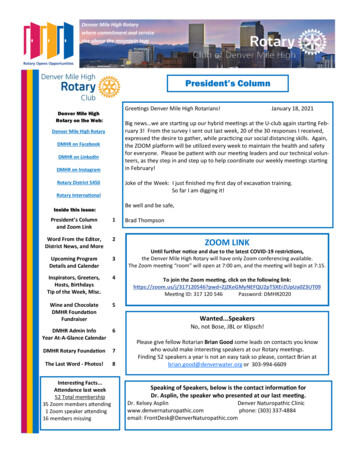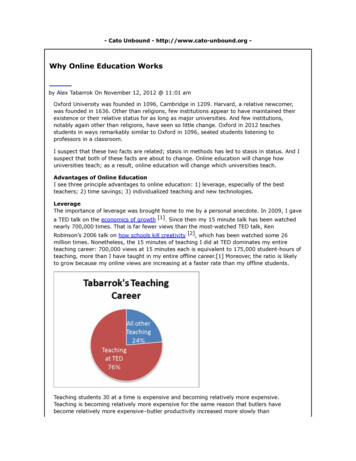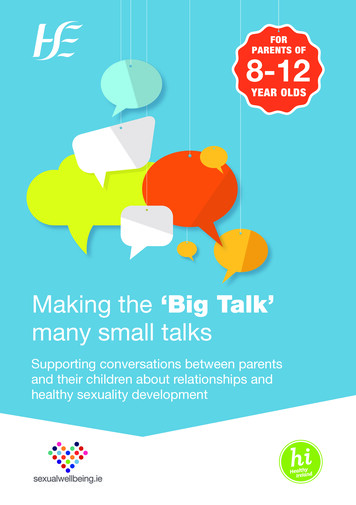
Transcription
Making the ‘Big Talk’many small talksSupporting conversations between parentsand their children about relationships andhealthy sexuality development
ContentsTalking with children aged 8–12 about relationshipsand healthy sexuality development2Why talk to your 8–12-year-old about relationshipsand healthy sexuality development?4Tips for talking with your child about relationships,sexuality and growing up 6The difference between sex and sexuality8Sex education and sexuality education8What are the common sexuality developmental needsof children aged 8–12?10Puberty 12Main physical changes of puberty 13Puberty and the female body15Breast development 16Menstruation/periods 17Puberty and the male body21Penis and testicle growth 22Erections 23Wet dreams 24Voice deepening 24Breasts 25Puberty changes common to all26Hair growth 26Personal hygiene 27Body image 28Masturbation 29Transgender child and puberty 30Intersex child and puberty 31Children with a physical and/or intellectual disability and puberty 32Reproduction/how babies are made 33
When questions make you feel awkward 34Adolescence 36Brain development 37Emotional development 38Social development 39Consent in relationships 40Gender identity 42Gender stereotyping 43Transgender 44Attraction and sexual orientation 45Homophobic and transphobic bullying 47Use of smartphones and digital devices 48Online sexual content 50Adolescents with an intellectual and/or physical disability 52Looking after yourself as a parent 53Glossary 54Where to get more help and information 56This booklet and other resources for parents are available todownload or order from healthpromotion.ieFurther information and advice for parents on the topicsof relationship and sexuality health can be accessed atsexualwellbeing.ieNotes on use1 Words highlighted in bold within the text are explained in the glossary.2 A small number of resources mentioned in this booklet are fromother countries. Any references to the law and to services will notapply to Ireland.Making the ‘Big Talk’ many small talks1
This booklet was developedto help you and your childmanage some of the changesassociated with puberty andadolescence.Making the Big Talkmany small talks:8-12 year oldsThis booklet is one of the ‘Making the Big Talk many small talks’series, which has been developed to help you talk with your childabout relationships and health sexuality development.‘Making the Big Talk many small talks: 8-12 year olds’ will helpyou and your child to manage some of the changes associatedwith puberty and adolescence. As your child moves through thisdevelopmental stage they will experience physical, emotional andsocial changes. This booklet and the ‘Busy Bodies’ booklet forchildren (also available from healthpromotion.ie/publications)will help you to prepare and support your child through thesechanges, focussing on the development of healthy attitudes andbehaviours about relationships and sexuality1.1 The word ‘sexuality’ is used in this booklet to refer to all aspects of a person’s sexualdevelopment: physical, social and emotional. It is not restricted to sexual orientationand sexual activity.2Making the ‘Big Talk’ many small talks
It’s normal to experience a range of emotions when faced with thistopic. Some parents may be used to talking about it and for othersit might be their first time. There may be some fear, nervousness,perhaps even excitement, at the possibility of shaping your child’sexperience. Memories of your own experience of growing up andof sex education may also lead to mixed emotions. Research findsthat most parents feel a bit challenged by the idea of talking withtheir children about relationships and sexuality but that most wantto do it. They know that by doing so, they can have a positiveimpact on the healthy development of their children’s sexuality.It is important that you don’t just wait for your child’s questionsbut consider in advance what they need to know to be supportedin this phase of their development. The good news is that there isno need for the ‘Big Talk’, just lots of small talks as you go along.Having the right support and information at the right time can helpyour child deal with growing up in a positive way.This booklet provides information about this stage of your child’slife and suggestions about what you might do and say to helpthem. It also signposts you to further sources of information andsupport.Remember that the booklet is ageneral guide to what is neededbetween the ages of 8 and 12,but you know your child and theirindividual needs best.Making the ‘Big Talk’ many small talks3
Why talk to your8–12-year-old aboutrelationships andhealthy sexuality development?Research finds that, knowingly and unknowingly, parents constantlypass on knowledge, attitudes and values to their children about thebody, relationships and sexuality2. Research also tells us that mostparents want to help their children to develop positive and healthyattitudes to their bodies, relationships and sexuality, and thatsexuality education has a positive impact on young people’s sexualhealth knowledge and their related behaviours3.A 2020 Irish study found that older teenagers who were sexuallyactive, who had discussed sex and relationships with their parentsby age 13, were significantly more likely to have used contraceptionat first sex4.As the parent, you are ideally placed to help your child navigate thechallenges ahead of them. You can help your child learn about theirbody, sexuality and relationships in a way that supports healthysexual expression. This is not just about the biological aspectsof sex but includes emotions as well. You can help your child toacknowledge their feelings and also to respect other people’sperspectives and rights. All of this will help your child make wiserchoices and develop healthy behaviours in relation to sexuality,relationships and sex as they mature.2 Conlon, C. (2018) Supporting Parents Communicating with Children Aged 4–9Years about Relationships, Sexuality and Growing Up.3 UNESCO (2018) International Technical Guidance on Sexuality Education; WHO(2010) Standards for Sexuality Education in Europe.4 ESRI (2020) Talking about Sex and Sexual Behaviour of Young People in Ireland.4Making the ‘Big Talk’ many small talks
By developing the habit of talking about relationships andsexuality, you lay the foundation for good communication betweenyou and your child. There may be embarrassing moments for youboth, but by talking, even when it is uncomfortable, you send themessage that it’s important to discuss sensitive topics. The moreyou talk, the easier it gets!Your challenge as a parent is to continueproviding love and boundaries to protectyour child, while also giving themincreasing responsibility and controlas they take the first steps towardsadolescence.The moreyou talk,the easierit gets!Making the ‘Big Talk’ many small talks5
Tips for talking withyour child aboutrelationships, sexualityand growing upEach child is unique and each family is different, buthere are some general tips that might help get youstarted:Be preparedUse books and videos at each stage of your child’sdevelopment to decide what messages about relationships andsexuality you would like to communicate.Start early and keep it simpleStart talking with your child about relationships, sexuality andgrowing up from a young age. This helps to normalise theseconversations and build healthy habits.Make it relevantThink of a pregnancy or new baby in the family, or a sexualityissue on screen or in the media, as an opportunity to talk.6Making the ‘Big Talk’ many small talks
Layer, don’t loadIt’s not a one-offperformance, so don’t tryto fit everything in at once.You can revisit topics as yourchild’s interest and understandingdevelops with age.Teach facts, then go furtherTalk to your child about your opinions and beliefs on allaspects of sexuality, including what makes for healthyrelationships.Be a ‘tellable’ parentReally listen to what your child is saying to you abouttheir life; about their joys, concerns and worries. They willcommunicate these to you through their words and actions.Be an ‘askable’ parentThrough your words and tone, welcome your child’scuriosity. Ask gentle questions to see what they alreadyknow. If you don’t have the answer to a question, it’s OK tosay that you don’t know but will find out.Teach body ownershipIt’s important your child understands that their body is theirown and they don’t have to let anyone touch them in away that’s unsafe and/or unwanted. This is the beginningof teaching them about consent. As they get older you cantalk about consent in relation to posting text or imagesonline, and later on, about sexual activity.Making the ‘Big Talk’ many small talks7
The difference betweensex and sexualitySex is what we do;sexuality is who we areAnna Freud (Psychoanalyst, 1895–1982)People use the word ‘sex’ to refer to sexual contact or activity andalso to describe whether a person is male or female. ‘Sexuality’ isa broader term, describing how we feel about and express ourselvesas sexual beings. This includes how we form relationships withpeople in our lives and how we relate to our society.Sex education andsexuality educationThe terms ‘sex education’ and ‘sexuality education’ are often used todescribe the same thing but in Irish schools the subject is referred toas Relationships and Sexuality Education (RSE). This is to emphasisethat although it includes issues around sexual activity in the olderyears, it is about much more than that. It is about how we supportchildren to understand and express all aspects of their sexualityin a healthy way and how we help them develop the attitudes,behaviours and skills necessary for respectful and supportiverelationships throughout their lives.8Making the ‘Big Talk’ many small talks
The Sexuality WheelThe Sexuality Wheel gives an idea of the many elements thatmake up or influence a person’s sexuality. It shows that ourunderstanding and experience of our sexuality and how weexpress it in the world is a core part of who we are as lorientationCommunicationSocialisationSexSelf imageExperiencesSexuality Wheel reproduced with kind permission of ‘Teachingsexualhealth.ca’Making the ‘Big Talk’ many small talks9
What are the common sexualitydevelopmental needs of childrenaged 8–12?The range of development between the ages of 8 and 12 is quitebroad. At 8 years children are often still very much children, whilechildren of 12 are very often on their adolescent journey. Althoughwe use age as an indicator of development only you know whatstage your child is at and what their needs might be.That said, it’s useful to have some idea of what is oftengoing on for children this age in terms of their sexualitydevelopment. They generally:form more same-sex friendship groups than previouslywant more privacy/personal spacewant to make more decisions/do more things independentlyof their parentsdevelop ‘crushes’ or fantasise about being in love (oftenwith celebrities). Some in the upper end of this age rangewill experience their first romantic or sexual attractionfeel the need to appear grown-up and smart – often aboutsexual matters, so may use sexual languagestop asking parents questions about sexuality issues,especially if any early efforts have met with a poor responseexperience some or all of the physical changes associatedwith pubertyexperience doubt or concern about the physical changes –worry whether their development is ‘normal’ compared topeersincrease physical self-exploration through self-touch/masturbation.10Making the ‘Big Talk’ many small talks
Puberty and adolescenceSometimes the words ‘puberty’ and ‘adolescence’ are used as ifthey mean the same thing, but although they are linked, they arenot the same.Pubertydescribes the physical changes thathappen when a young person’s body startsto become more like an adult’s body.Adolescencedescribes the stage in life between beinga child and being an adult, covering theteenage years.Making the ‘Big Talk’ many small talks11
PubertyPubertyPuberty is when a child’s body begins to changeinto the body of an adult, capable of reproduction.Hormones are released, leading to rapid change,physically, emotionally and socially.Physical developmentFemale BodyMale Body12Making the ‘Big Talk’ many small talks
PubertySome things to know:On average, female bodies start puberty between 9and 11 years of age and male bodies start around 12years of age. Even if your child’s development fallsoutside this range it can still be healthy. Talk to your GPif you are concerned. The table below shows the mainphysical changes that occur in the body during puberty.Main physicalchanges of pubertyCommon to all bodiesHair growthunder armsand on legsPubic hairgrowsaround thegenitalsOil glands inskin producemore oil whichcan lead tospots or acneSweatproductionincreasesMaking the ‘Big Talk’ many small talks13
PubertyMale bodies onlyHair growthon body,chest andfaceBody growstaller andusually broaderaround thechest andshouldersVoicedeepensTestes andscrotumgrowPenis growsFemale bodies onlyBreastsgrowBody growstaller andcurvier, hipswidenOvariesreleaseegg cellsMenstruation(periods)beginsIncreased spontaneouserections and wet dreamsmay occur.Body is capable ofejaculating semenfor the first time14Making the ‘Big Talk’ many small talks
PubertyPuberty andthe female bodyStages of pubertyStage1Stage2The trigger for puberty in the female body is theproduction of particular hormones in the brain. Thesehormones travel through the blood to the ovaries tostart the pubertal development of your child. Physicalchanges aren’t noticeable at this stage.The ovaries begin releasing oestrogen andprogesterone. Hormones race around the body leadingto physical changes. Breast buds start to form under thenipple. Your child gets taller; hair starts to grow underarms, on legs and around the pubic area.StageBreasts carry on growing and pubic hair gets thicker.Hips get wider. The vagina releases a clear, white or offwhite mucus (discharge) which helps it to stay clean andmoist. It also helps prevent and fight infections.StageThe ovaries release an egg (ovulation) which, if notfertilised, is shed from the body along with the blood andtissue from the womb lining, in the form of a period. Skingets oilier and can cause spots.StagePuberty finishes when your child reaches their adultheight, when breasts finish growing and their menstrualcycle is established.345Making the ‘Big Talk’ many small talks15
PubertyBreastdevelopmentSome things to know:The first sign of breast development is the nipples growing;they may be puffy or sore during this time. These are knownas breast buds. The breasts continue to grow for about 5to 6 years. Children can be quite self-conscious when theirbreasts are developing as they may not develop at thesame rate as their peers or they may develop quicker thantheir peers. All breast sizes are normal and the breasts mayeven be different sizes. Breasts can feel lumpy and sore asthey grow. Some people continue to experience this breasttenderness before they get a period until menopause occurslater in life.What you might do:Shop together for a first bra orarrange for someone with whom yourchild is comfortable to do it. Yourchild might also want to wear a croptop before they have need of a bra.16Making the ‘Big Talk’ many small talks
PubertyMenstruation/periodsSome things to know:A period is blood and tissue from the womb (uterus) leavingthe body through the vagina. Periods happen because thefemale body has two ovaries containing millions of tiny eggsand one of these ripens and is released every month. Whenpuberty arrives, hormones tell the body to release the firstegg. The egg travels down one of the fallopian tubes tothe uterus. The uterus has prepared for the egg by buildinga thin lining of blood along the walls. If the egg isn’t fertilisedby a sperm, then the body releases the egg and the liningof the womb breaks down, leaving the body as a period.Although it can feel like more, the amount of blood lost ina period is only about one egg-cup full. Periods can taketime to settle into a pattern, and most females will developa regular menstrual cycle of roughly every 28 days, withperiods lasting for 3 to 5 days. Periods usually start abouttwo years after breasts begin to grow (bud).Periods happen because the femalebody has two ovaries containingmillions of tiny eggs and one of theseripens and is released every month.Making the ‘Big Talk’ many small talks17
PubertyPre Menstrual Syndrome (PMS):Some people experience PMS before they gettheir period. This can involve mood swings,cramps, tender or swollen breasts and/or bloating.Menstrual Pain:Many people experience some level of pain duringtheir period. This can usually be managed withsome mild pain medicine, local heat and gentleexercise. If period pain is moderate to severe orif the bleeding is heavy and disrupts your child’sschool or home life, speak with your GP.Healthy vagina:A healthy vagina releases a sticky substancethat may be seen on underwear. This iscompletely normal and not a cause for concern.Occasionally there may be some itchiness orsoreness around the vagina, and sometimes thesticky discharge may turn white and becomethicker. This may be a mild form of thrush, whichis common in pubescent girls – it is causedby the overgrowth of yeast in the vagina andis perfectly normal. It usually goes away onits own but if it persists or if your child is veryuncomfortable, speak to your pharmacist or GP.18Making the ‘Big Talk’ many small talks
PubertyBusyWhat you might do:BodiesBusy Use the HSE’s Busy Bodies booklet or otherresources to explain the menstrual cycle toyour child and cover what happens when theyget their period, how to deal with it, how longit can last and how frequently it happens.ThiseditionHSE,of theHealthBusyBoPromoHSE,Sexualtion and dies booklet waHealthImprovs devand CriementelopedWithsis Pre,thaby:gnancy Cork Kerry BeL nks to theCommPrograadvisoonGTOunitymme DeHealthry gropartme Youth Serup witcarevich repnt of HSresentEducat eE, Heativesalth Proion Nafrom:tionalmotion and SkillsCouncInspec Naand Impil fortionaltorarovemCurricParent Proent, Co teulums’ Cofessioandmmuncnal De SexunityAssessvelopm il – PrimaryHealthual Hementcareent Seralth CeOrganivicentre,sationfor TeaCorkWith1chersadditional thanks tothe PDPublisST Hehed byalth andthe HSE, SexWellbeual Heing Adalth andvisorsCrisisPregnancy Programme 2020BodiesA booklet aboutpuberty andadolescence foryou and your parents Rather than try to get everything into one conversation,drip-feed the information and give more detail as needed. In addition to explaining about periods, reassure your childthat the sticky white substance (mucus) that is dischargedby the vagina throughout the monthly menstrual cycle iscompletely normal and healthy. Discuss the various sanitary products which your childmight use and how to use and dispose of them. Peoplegenerally start with sanitary towels but there is a growingvariety of products available, including many moresustainable methods, e.g. menstrual cups, reusable orbiodegradable pads. Help your child make up a period pack fortheir school bag with sanitary towels andspare underwear. Discuss what to do ifthe period comes during school hours, anactivity or when your child is away fromhome. This might include how to makean emergency pad with toilet paper andidentifying a teacher or another adult towhom they could go for assistance.Making the ‘Big Talk’ many small talks19
Puberty Talk about the need for increased hygiene, for example,changing sanitary towels and tampons regularly to avoidinfection and washing the genital area. It is a good idea notto use perfumed products on the genital area as this cancause infection. Discuss how to manage possible cramps using heat,exercise, a bath or, if necessary, painkillers. Don’t put offgoing to the doctor if your child experiences recurrent painthat interferes with their life. Explain to your child that during puberty their body willbecome physically capable of having a child but it will bea long time before they are old enough to take on all that’sinvolved in pregnancy, childbirth and raising a child. Thismight be obvious to you but maybe not to them!It’s a good idea to talkto your child aboutmenstruation well beforetheir first period so they areprepared and not shocked orfrightened. Children who areprepared are likely to have abetter experience and ask forhelp if they need it.20Making the ‘Big Talk’ many small talks
PubertyPuberty andthe male bodyStages of pubertyStageThe trigger for puberty in the male body is theproduction of particular hormones in the brain. Thesehormones travel through the blood to the testes tostart the pubertal development of your child. Physicalchanges aren’t noticeable at this stage.StageThe testes start producing testosterone and sperm.Testicles grow larger and hair grows around the pubicarea. Your child grows taller following a growth spurt.StageThe penis grows longer and the voice deepens.Wet dreams may start.StagePubic hair continues to grow and the penis gets thickerand longer. Skin gets oilier and can cause spots. Hairgrows under arms and on upper lip and chin.1234Stage5Puberty finishes when your child reaches their full adultheight, shoulders widen and facial hair grows regularly.Making the ‘Big Talk’ many small talks21
PubertyPenis and testicle growthSome things to know:The penis and testicles grow during puberty and testicles begin toproduce sperm. Semen, the liquid containing sperm, can now beejaculated through the penis. The size and shape of the genitalsvary from person to person and a person’s two testicles are usuallyslightly different in size. It’s normal for one testicle to hang a littlelower than the other. The scrotum (skin holding the testicles)tightens in the cold and loosens in warmth to hold the testicles atan ideal temperature.What you might do:22 Explain to your child that their genital areaand penis needs to be cleaned regularly. Ifthey have an uncircumcised penis they needto gently pull back the foreskin and cleanaway any smegma, a thick white substance.This is a natural lubricant but, if leftunwashed, it can cause infection and odour.Remind them that they should never forciblyretract their foreskin. If your child experiences severe or prolongedpain in the genital area, seek immediatemedical advice. This is particularly importantif they also feel sick and vomit.Making the ‘Big Talk’ many small talks
PubertyErectionsSome things to know:An erection is when the penis gets hard in response to feelingsexually excited. Sometimes spontaneous erections that are notlinked to anything sexual may occur. These can be awkward foryour child, especially if it happens during the day when they areout and about. An orgasm at this age may result in semen beingejaculated and this is likely to contain sperm.What you might do:Give your child a bit more privacy in themornings as many children experienceerections first thing. While spontaneouserections are awkward, they are normaland your child will learn to gain controlover them as they get older. Waysto manage them include deliberatelythinking of non-sexual things, wearingloose underwear, untucking a shirt orcarrying their bag in front of them untilthe erection subsides.Making the ‘Big Talk’ many small talks23
Wet dreamsSome things to know:A wet dream is when semen comes out of a peniswhile the child is asleep. This is a commonoccurrence during puberty. It cannot be controlled;it’s all part of growing up and will eventually settle.What you might do:Reassure your child that wet dreams are verycommon during puberty; it’s just a part of theirbody growing up. Remind them to change theirunderwear and bedding as necessary.Voice deepeningSome things to know:For most children, this generally happens sometimebetween the ages of 11 and 15 but usually after a largegrowth spurt. Some children may be self-conscious abouttheir voice changing.What you might do:Reassure your child that this is a temporary but normal partof growing up, and acknowledge that although this can beawkward at times, it will pass. Be aware of the possibleimpact of teasing if your child is sensitive about this.24Making the ‘Big Talk’ many small talks
PubertyBreastsSome things to know:It is not uncommon for males to experience thegrowth of breast tissue and tenderness around the nipplesduring puberty. Their bodies are producing more hormones,including the female hormone oestrogen, and can takea while to settle down. Although male breasts don’t tend togrow particularly large, children can feel very self-consciousand may need your support. Male breast growth is usuallytemporary and is not generally a health problem, but in asmall number of cases there may be underlying causes.If your child is carrying excess weight, they maybe more prone to the growth of breast tissue andmay also have a layer of fat under the chest skin.Achieving a healthy weight should help resolvethe issue.What you might do: Reassure your child that this isa normal part of puberty for somepeople and will sort itself out intime. Suggest that they wear loose tops if thishelps them feel more comfortable. Talk to your GP if you or your child isconcerned.Making the ‘Big Talk’ many small talks25
Puberty changescommon to allHair growthSome things to know:During puberty, the young person will experience hairgrowth on their body, under their arms, on their legs andaround their pubic area. For males, facial and chest hairgrowth is common. Noticeable facial hair usually happensaround 15 to 16 years.What you might do:Reassure your child that hair growth in these areas isnormal. When they are older, if your child decides to shaveor remove hair in other ways, give them some tips on how toavoid irritation or cuts. It is also important to teach shavinghygiene such as not sharing razors as these can hold tracesof blood and bacteria which can spread infections.26Making the ‘Big Talk’ many small talks
PubertyPersonal hygieneSome things to know:During and after puberty, children develop hair around thebody, the oil glands in their skin produce more oil and theyalso sweat more.What you might do:It is important to develop a good hygiene routine froman early age to deal with body odour and protect againstinfections. Poor hygiene can impact on your child’sconfidence. Encourage daily washing and use of deodorantor antiperspirant. Ensure they regularly change and washclothes, with underwear and socks being changed daily. Ifyour child develops acne, encourage them to gently washtheir skin with a mild soap product daily. If it is a significantproblem, talk to your pharmacist or GP.Making the ‘Big Talk’ many small talks27
PubertyBody imageSome things to know:The physical changes that occur during puberty can affecta child’s body image. Some children will be delightedat their emerging adult body and others may feel lesspositive. They may also get comments from other peoplethat affect how they feel.What you might do:During puberty, young people tend tocompare themselves to their peers.Although this is natural, it is not helpful.Encourage them to focus on thepositives of their developing body. Itcan be helpful to challenge the ‘perfect’images in media and magazines anddiscuss with them how they feel abouttheir body. Help them take care of theirbody with good hygiene, food, sleepand exercise. A healthy body image isan important part of your child’s overallhealth now and later in life.28Making the ‘Big Talk’ many small talks
PubertyMasturbationSome things to know:Masturbation is when a person touches their genitals forpleasure. This is a normal part of healthy sexual developmentand is common in adolescence. Contrary to the old myths,masturbation is generally not considered to have anyhealth risks and may have some health benefits as theyoung person becomes familiar with their own body ina safe way. Some young people may become obsessedwith masturbation for a time, but this will usually pass.While masturbation is common, not every young personmasturbates. Some have no interest and some abstain forreligious, cultural or personal reasons.What you might do:Reassure your child that masturbationis a normal part of sexual development.Ensure they understand that this is aprivate activity and good hygiene shouldbe practised. If you wish to talk to your childabout abstaining for religious, cultural or otherpersonal reasons, try to do so in a way that is notshaming for the young person.Making the ‘Big Talk’ many small talks29
PubertyTransgender childand pubertySome things to know:If your child is exploring their gender identity or hasidentified as transgender, puberty can be a particularlyconfusing time. Their body may be changing in ways thatdon’t match their sense of themselves.What you might do:As parents, you may want to prepare foryour child’s possible need for additionalemotional and practical support during thisimportant developmental stage. You mightwant to contact the BeLonG To Youth Serviceor Transgender Equality Network Ireland(TENI). See the ‘Where to get more help andinformation’ section for contact details. Ifnecessary talk to your GP.30Making the ‘Big Talk’ many small talks
PubertyIntersex childand pubertySome things to know:People who are born with variations in their sexual anatomy,in their chromosomes or in their hormonal patterns thatare not seen as typical of male or female bodies are called‘intersex’. If your child is intersex, additional physical andemotional issues may arise during puberty relating to theirindividual circumstances.What you might do:As parents, if you know in advance that your childis intersex, you may want to prepare for your child’spossi
This booklet is one of the 'Making the Big Talk many small talks' series, which has been developed to help you talk with your child about relationships and health sexuality development. 'Making the Big Talk many small talks: 8-12 year olds' will help you and your child to manage some of the changes associated with puberty and adolescence.

